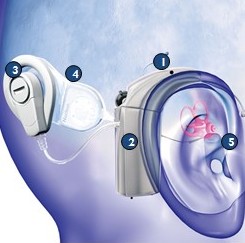 Q. How does a cochlear implant work?
Q. How does a cochlear implant work?
A. A cochlear implant works as follows (see diagram):
- Similar to a hearing aid, acoustic sound is captured by the microphones on the speech processor.
- The speech processor analyzes the signal and converts it into digital codes.
- This digital signal is then sent via the cable to the coil of the processor, which stays connected to the patient’s head via a magnet. The signal is transferred through the headpiece across the skin to the internal implant located under the skin.
- The implant turns the received digital information into electrical information that travels down the electrode array to the auditory nerve.
- The auditory nerve sends impulses to the brain, where they are interpreted as sound.
Q. Is cochlear implant technology new?
A. The first cochlear implants were performed in 1961, when Dr. William House implanted the devices in three patients. These devices were made up of a single electrode. Improvements were made to allow for multiple electrode sites, and from 1964 to 1966, procedures were performed using this new technology. In the 1970s, implant technology became even more advanced, and in 1984, the Food and Drug Administration approved the implant process in adults. Candidacy for implants has since expanded to children and to people with more residual hearing, and advancements have continued to be made in the device’s sophistication and programming. Currently, three cochlear devices are FDA-approved to be implanted in children.
Q. Are there surgical risks with a cochlear implant?
A. While the risks during the surgical procedure are considered minimal, the FDA lists the following as possible risks: injury to the facial nerve, meningitis, cerebrospinal or perilymph fluid leak, infection, blood or fluid collection at the site of surgery, dizziness, tinnitus, taste disturbance, numbness around the ear, or reparative granuloma.
Q. What about the risk of meningitis?
A. Because children with cochlear implants are at increased risk for contracting meningitis, the Centers for Disease Control and Prevention recommends that children who receive a cochlear implant follow the recommendations for pneumococcal vaccinations that also apply to other groups at risk.
Q. Can my child have an MRI with a cochlear implant?
A. In some cases, the magnet from the cochlear device must be surgically removed prior an MRI exam. Most implants allow for an MRI with a magnet strength up to 3.0 tesla without surgical removal of the cochlear magnet.
Q. Are there alternatives to cochlear implants?
A. Yes, cochlear implant surgery is considered elective surgery and not medically necessary. Our team believes that amplification and communication choices are a personal decision, and our goal is to ensure that families have information about all of their options in order to make an informed decision. Among the most common options are continued use of hearing devices, reliance upon assistive-listening devices, use of real-time translation and use of American Sign Language. For more on cochlear implant alternatives, see the Parent Resources section.
Q. What does a cochlear implant evaluation involve?
A. The cochlear implant evaluation is completed by a multidisciplinary team of surgeons, audiologists, speech-language therapists, developmental psychologists, and an educational liaison. Many factors must be taken into consideration in determining whether a child is a candidate for the procedure. Candidates will most likely receive an audiological evaluation, Auditory Brainstem Evoked Response/Auditory Steady State Response Test, speech perception test battery, balance testing, speech-language evaluation, developmental evaluation, educational evaluation, medical evaluation with CT and MRI scans, vision testing, vaccinations, and genetic testing.
Q. How soon after the procedure will I notice a change in my child? And what should I expect from therapy?
A. It may take six months or longer after the procedure for a child to become used to the new sounds they hear. Therapy is an ongoing process, and how soon a change is noticed depends on the age of the child, the needs of the child, and the services the child is receiving in school. For the implant to be successful, it is critical that the skills learned in therapy be carried over to the home environment.
Q. How many hours a day will my child need to wear the implant?
A. For maximum benefit, the child should wear their processor during all waking hours. A typically hearing child is exposed to sound every waking minute, and it is important that a child who receives a cochlear implant also be exposed to sound every waking minute. The equipment also must be checked often to ensure that it is working properly.
Q. Will my child hear the same was as a typically hearing child with their cochlear implant?
A. No, a child who receives a cochlear implant will perceive sound differently than a typically hearing child. Background noise may interfere with your child’s ability to discern that someone is talking. When your child is far away from the speaker, it will be more difficult for them to receive a clear signal and understand spoken conversation. Because of this, attempting to have conversations from a different room should be avoided.
Q. Will my child be able to listen to music and watch television?
A. Many people with cochlear implants listen to music and watch television. Some can do this without using captions, others prefer the use of closed captioning. We are happy to talk with you about options that can assist in these areas.
Q. Will my child be able to use the telephone?
A. We know that research shows that not all people who receive a cochlear implant can use the telephone. It is possible that your child may be able to learn to use the telephone without difficulty or only use it in a limited way. There are many options we can discuss to help with this if the use of the phone is critical to you and your child.